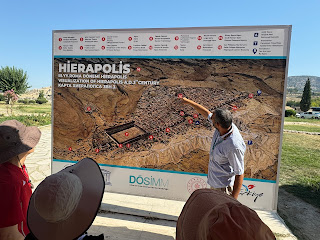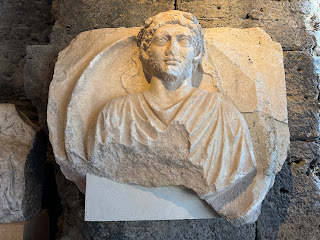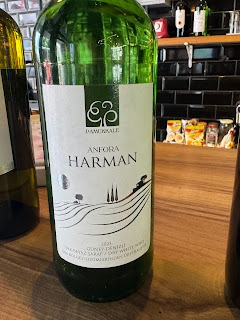2024-08-20
Pamukkale: A Canvas of Time and Nature
The breakfast spread at the hotel was a symphony of flavors. Cheeses, a testament to the region's bounty, beckoned with their creamy richness. Dried fruits, jewels crystallized by the sun, offered a sweet counterpoint. Shiqin, with a boldness I admired, reveled in the fiery embrace of a jalapeño, its heat a brief dance on her tongue, a contrast to my own aversion to such piquant provocations.
Hierapolis: Echoes of Antiquity
The heat of the day was oppressive, a relentless sun beating down at 38 degrees Celsius. The air itself seemed dry, a stark contrast to the humid embrace of Singapore. The vegetation, though parched, clung to life, waiting for the tiniest drop of water to spring back into vibrancy. Our guide, Babur, a font of knowledge, regaled us with tales of the ancient people who once inhabited Hierapolis, weaving biblical references into the tapestry of history.
Hierapolis, perched atop the travertine terraces, was a testament to both human ingenuity and the artistry of nature. Its strategic location, at the confluence of hot springs and fertile plains, nurtured a thriving metropolis in antiquity. The city's grandeur echoed in its well-preserved ruins, each stone whispering stories of a bygone era.
The necropolis, a vast cemetery stretching across the landscape, was a haunting yet captivating spectacle. Elaborate tombs, carved from marble and adorned with intricate sculptures, stood as silent guardians of the city's departed. Babur spoke of the possibility that Philip, the apostle, met his martyrdom here, his body perhaps interred within this expanse. The image of his crucifixion, head down, was a stark one.
Another wonder was the Plutonium, a cavern filled with carbon dioxide gas. For the ancients, it was the entrance to the underworld, a sacred site for religious rituals. While the gas was now safely contained, the eerie atmosphere lingered. A modern replica depicted Hades, the brother of Zeus and Poseidon, seated with his three-headed dog and two, I presumed, infernal snails.
Pamukkale's Thermal Embrace
The vista from Pamukkale is nothing short of breathtaking. As you gaze upon the cascading white travertine terraces,bathed in the warm glow of the setting sun, you'll be captivated by the surreal beauty of this natural wonder. The combination of the snow-white terraces, the ancient ruins of Hierapolis, and the surrounding lush valleys creates a truly unforgettable scene.

The Hierapolis Archaeological Museum housed a trove of intriguing artifacts, a testament to the wealth of ancient relics slumbering beneath Turkey's soil. Each excavation, it seemed, unearthed another treasure. Here, I encountered Eumenes II, King of Pergamon, his likeness captured in a sketch within my notebook. Sarcophagi and funerary objects lined the halls, remnants of lives long past.
Lunch was enjoyed at the Belle Bar & Restaurant in a nearby town. The menu boasted local wines, a subject on which I was woefully undereducated. Snapping photos of the bottles, I pledged to consult my friend Philip, a true Turkish wine connoisseur, in the next phase of the trip.
Colossae: Yet to be Restored
Colossae offered little to the visual eye, its ruins merely a collection of stones protruding from the earth. Our guide, referencing biblical passages, spoke of the refreshing cold springs that once graced Colossae, a stark contrast to the heat we endured. This theme, he promised, would be further explored at Laodicea.
Laodicea: A City of Contrasts
Laodicea, renowned for its black wool, a prized commodity among the Roman elite, had reaped the rewards of its economic prowess. The city's reputation extended beyond its textile industry; it was also celebrated for its eye salves, believed to possess healing properties.
As I delved into the biblical passage, Revelation 3:14-22, the words took on a new resonance. The Laodicians, once wealthy and influential, had succumbed to spiritual complacency. Their lukewarm faith, a reflection of their worldly affluence, had earned them a rebuke from Jesus.
The Lost Mural of Laodicea
The ancient city of Laodicea once boasted a colossal mural, a testament to the artistic prowess of its inhabitants. Though time and the ravages of nature have obscured much of its detail, the sheer scale of the mural remains awe-inspiring. To stand before its remnants, to trace the outlines of its faded imagery with one's fingertips, is to connect with a lost world, to feel the brushstrokes of history upon one's own skin. The mural, a silent sentinel of the past, invites the imagination to fill in the blanks, to envision the vibrant colors and intricate designs that once adorned its surface.
Returning to the hotel, Doga Thermal Health & Spa, we were greeted by a sumptuous spread. Shiqin, with a playful spirit, likened one of the desserts to smell like Ikea! So random, but memorable. The day, a tapestry woven with threads of history, culture, and natural beauty, had come to a close.









































No comments:
Post a Comment